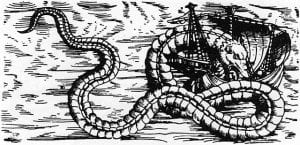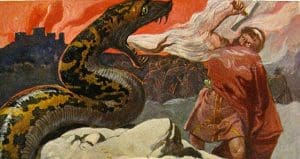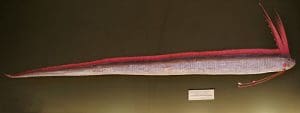From the earliest days of human exploration of the sea, sailors and fishermen have told stories of weird, terrifying creatures. Rampaging devil whales destroying ships, primitive creatures in remote lakes, and sea serpents that stretch for miles all appear in old legends and stories of the mysterious depths. As strange and ancient as these tales are, perhaps there may be some long-lost truth in them? Read this article to learn about sea monster legends and the reality that inspired them, and check out CRRL’s collection for books on the many monsters of the deep!
Devil Whale, the Breaker of Ships
A monster need not be an extinct creature or legendary beast; sometimes, a normal animal may become distorted into a horror through the power of imagination and exaggeration. Stories of sailors being pitted against a vast, horrific “devil whale” persisted over the centuries, even though human understanding of whales was limited. Whaling has been practiced by people for thousands of years, but, for most of that time, it was subsistence hunting rather than an organized industry. This period of lesser danger for whales would end with the Industrial Revolution and the advent of the whale oil industry. Whale oil is made by boiling whale blubber and was the preferred lighting source of many industrial societies before electrical lights were widely used. By the early 1800s, the United States had one of the world’s biggest whaling fleets, which was centered in New England. It was then that a terrifying encounter would inspire one of the classics of American literature.
By the early 19th century, whale populations on the East Coast of the US had declined from decades of whaling. Whaling ships were forced to travel far from New England’s waters and seek out the valuable spermaceti from sperm whales to make their voyages profitable. The whaling ship Essex departed from Nantucket on August 12, 1819, for a voyage planned to last two and a half years and headed for the western coast of South America. Only two days out of port, the ship was hit by a massive storm that destroyed two of its whaleboats. Captain Pollard pressed onwards to South America and ignored the complaints of his crew that the storm was an ill omen. The Essex eventually reached Cape Horn, where its crew managed to kill many whales that lived close to the shore. Once the supply of whales was exhausted, Pollard decided to search for more at a spot farther out at sea. Another ill omen occurred; during a resupply on Floreana Island, crewmate Thomas Chapple set a fire as a prank that burned out of control and engulfed the island’s forests.
After reaching the whaling spot, tensions among the crew continued to increase. The crew was unable to sight a whale for days, and the first sighting of a whale on November 16, 1820, resulted in the destruction of another whaleboat. Four days later, first mate Owen Chase was on deck, hammering on the damaged whaleboat to repair it. While he was doing this, a massive bull sperm whale began to move closer to the ship, finally rushing in to ram the Essex, then diving back into the depths. The whale suddenly resurfaced on the starboard side and rammed the Essex again, and the second blow hit hard enough to sink the ship from the bow. The 20 men of the Essex’s crew fled the sinking wreck with all the supplies they could, but much of the food had already been contaminated by saltwater. Three of the crewmen died before reaching even the nearest land, Henderson Island, and the crew began to split up and journey in different directions on their boats in search of survival. Only eight of the crew survived in total, Captain Pollard and Owen Chase among them. Chase’s memoir, The Narrative of the Wreck of the Whaleship Essex, inspired novelist and former whaler Herman Melville to write his classic novel Moby-Dick about another doomed whaling expedition. It was Melville’s book about the “white whale” that forever burned the concept of the devil whale into the American psyche.
World-Ending Snake, the Midgard Serpent
Perhaps the most formidable and terrifying sea monster of all was the legendary Midgard Serpent. Also known as the World Serpent because its body was believed to have spanned all the waters that surrounded Midgard (our world), the Midgard Serpent was so vast and powerful that no mortal man could ever hope to slay it. It was the most powerful enemy of the god Thor, and his journeys to vanquish it form a major part of the stories of Norse mythology. In one story, Thor goes fishing with the giant Hymir, but Hymir refuses to give him bait for his rod. So Thor cuts the head off Hymir’s largest ox, puts it on his rod’s hook, and requests to go far out into the ocean. Despite Hymir’s protests, Thor rows far away from land and casts his line. Once the Midgard Serpent bites, its pull is so strong that it nearly pulls Thor overboard! Just as Thor finally gets the upper hand and is preparing to strike it dead with his hammer Mjolnir, Hymir’s terror gets the best of him, and he cuts Thor’s fishing line. The Midgard Serpent escapes back to the bottom of the ocean, and Thor punches Hymir off the boat in frustration.
At Ragnarok, the battle at the end of the world, Thor encounters the Midgard Serpent for the last time. The great beast rises up with the other forces of chaos to challenge the gods and destroy all that is, and Thor can not help his father Odin battle the Fenris wolf because the serpent confronts him. After a titanic struggle, Thor finally brings Mjolnir down on the serpent’s head, destroying his hated enemy. But during the lengthy battle, the poisonous fumes of the Midgard Serpent’s breath get deep into Thor’s lungs. The mighty god can only walk nine paces before he falls from the effects of the venom, never to rise again.
What real animal could have inspired a legend as horrifying as the Midgard Serpent? There are true sea snakes, but they live in the warm waters of the Indian and Pacific Oceans, far from where the Norse sailed. The actual “sea serpent” the Vikings knew was most likely an oarfish. Oarfish are not snakes, but fish with very long bodies. They have a global distribution, and the giant oarfish’s maximum length may be 36 feet! Oarfish are rarely caught because they live deep in the ocean in the mesopelagic zone, where light is scarce. The giant oarfish is most often seen by humans when it washes up on a beach, sometimes following an earthquake. With its dragon-like head and long, narrow body, the giant oarfish could very well have been the source of the Midgard Serpent legend.
Nessie, Lord of the Loch
Many sea monsters are based in ancient folklore and legend, but descriptions have changed over time with the recent popularity of cryptids and paleontology. One of the most notable of these is the mysterious “Nessie,” the Loch Ness Monster. Descriptions of strange creatures lurking in the water of Loch Ness, a large lake in northern Scotland, are quite old. Early versions of Nessie are much less like a living animal than a kelpie, a horse-like water demon of Celtic folklore. The kelpie is typically given the form of a beautiful black horse with its hooves reversed that rises up from water to entice people to follow it into the depths. The earliest known association of Loch Ness with the kelpie dates to 565 AD, during the Christianization of Scotland. According to the legend, a man was swimming in the lake and was about to be devoured by a kelpie that had emerged from the depths. Saint Columba yelled out to the creature to “go back with all speed” in the name of God, and the man’s life was saved.
This story gave the first popular form of the Loch Ness Monster, and the mythic concept of the kelpie would remain the standard for centuries. Eventually people sought a more scientific explanation for the legendary beast, and the cryptid Nessie first appeared in 1933. The first modern Nessie sighting was made by George Spicer and his wife, who spotted a gray creature with a large body and a long, trunk-like neck that looked like a “scenic railway.” It was a newspaper report of this sighting that caused the name “Loch Ness monster” to be coined. Motorcyclist Arthur Grant sighted Nessie the following year while riding his motorcycle and described a creature with a long neck, bulky body, and flippers for feet. The year 1934 would also see the publication of the “surgeon’s photograph,” supposedly taken by Robert Kenneth Wilson that was the first image of Nessie’s head and neck.
That image and these two accounts would crystalize the image of Nessie as a plesiosaur in the minds of cryptid hunters and fans of legendary monsters. But what were these ancient sea creatures really like, and could one survive in remote Loch Ness? Plesiosaurs were a group of marine reptiles that lived in oceans all over the world during the Mesozoic, the age of dinosaurs. They disappeared from the fossil record about 66 million years ago, likely victims of the meteor impact that killed the dinosaurs and most life on Earth. But several recent discoveries make the survival of plesiosaurs in the form of Nessie less likely. A 2011 study of a plesiosaur fossil strongly suggests that plesiosaurs bore their young live in the open ocean. If plesiosaurs could bear live young, they would not need to crawl on land like sea turtles to lay eggs, as some accounts of Nessie suggest. An even more recent discovery from 2022 offers a peek into plesiosaur metabolism. Using a molecular marker for metabolic stress, scientists analyzed the bones of various groups of extinct reptiles to determine whether they were warm- or cold-blooded. Plesiosaurs were among the groups suggested by the study to be warm-blooded, but this would mean they would have a larger appetite than the cold-blooded reptiles of today.
What strange creatures will you discover in the depths of CRRL’s collection? There’s a panoply of tales of the sea to discover in its grotto of books. Come in and see what you can find.
Books that feature stories about or information on legendary sea monsters and the real animals that may have inspired them.






